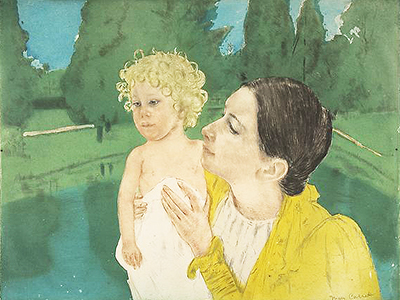By the Pond is painting done on three plates on greenish-gray laid paper, with color drypoint and aquatint medium, in the year between 1893 and 1903. It is signed in pencil, on Vanderley laid paper, with margins, in good condition apart from three very pale fox marks in the lower sheet at the far left.
There is a pale discoloration in the margins, a flattened horizontal crease through the lower margin, near the edge of the sheet. This paint, By the Pond, was among a series of high original drypoint and aquatint prints. It is greatly inspired by the Japanese masters. What is attractive about this paint, By the Pond, is its simplicity and clarity. Its careful use of blocks of color especially light, delicate pastel colors while avoiding the forbidden black color. In the paint, By the Pond, the format and color scheme is likely to have been inspired by the bright glaze ceramic relief sculpture created by Della Robia. The tone of colors, contrast, its perspective, and depth creates traces in the viewer's imagination and appears to be thought provocative.
In the paint, By the Pond, a mother is seen holding her baby right after bathing him. The mother's cloth is yellowish in color against a white towel that the baby is wrapped in. The pond lies right behind them and further into the background are trees and vegetation covered in green. The mother's face is seen to be in complete harmony with her baby, although the baby's face is looking away from her mother, deliberately avoiding her eye contact. The mood of the paint is calm and peaceful. Both the subjects of the paint are located in the center of the paint. Mary Cassatt is famously known for her intimate scenes depicting mothers and their children as evident in this painting.
Mary Cassatt drew encouragement from painter Edgar Degas, a friend, and mentor, to continue working in her own direction. Her legacy includes her love to support young, American artists in their work. She has also been known to support the fledging movement and she later became an advisor to numerous major art collectors, with the belief that their contribution would eventually be passed on to art museums. Among her popular works includes In the Box of 1879, Children Playing On The Beach of 1884, The Bath between 1890 and 1891, Summertime of 1894, Madame Meerson and Her Daughter of 1899 and Maternity of 1897, among many others.




